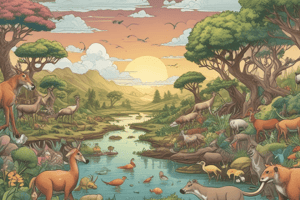Podcast
Questions and Answers
What is the primary difference between a food chain and a food web, and how do they relate to each other in an ecosystem?
What is the primary difference between a food chain and a food web, and how do they relate to each other in an ecosystem?
A food chain is a simple, linear sequence of who eats whom, while a food web is a more complex network of interconnected food chains, showing how organisms are connected in an ecosystem.
What is the primary function of the carbon cycle in regulating Earth's climate and supporting life?
What is the primary function of the carbon cycle in regulating Earth's climate and supporting life?
Providing energy for living organisms and regulating Earth's climate
What is the role of decomposers in an ecosystem, and how do they interact with other organisms?
What is the role of decomposers in an ecosystem, and how do they interact with other organisms?
Decomposers, such as bacteria and fungi, break down dead plants and animals, returning nutrients to the soil, which are then used by producers to support the entire food chain.
What is the essential element that the phosphorus cycle provides to living organisms, and what is its function?
What is the essential element that the phosphorus cycle provides to living organisms, and what is its function?
What is the primary role of the oxygen cycle in supporting life on Earth?
What is the primary role of the oxygen cycle in supporting life on Earth?
Describe the process of condensation in the hydrological cycle, and explain its importance in maintaining ecosystem balance?
Describe the process of condensation in the hydrological cycle, and explain its importance in maintaining ecosystem balance?
Define the term 'biogeochemical cycle' and explain its significance in the context of ecosystems?
Define the term 'biogeochemical cycle' and explain its significance in the context of ecosystems?
How do tertiary consumers impact the structure and function of an ecosystem, and what would happen if they were to disappear?
How do tertiary consumers impact the structure and function of an ecosystem, and what would happen if they were to disappear?
What is the importance of the nitrogen cycle in building proteins and DNA?
What is the importance of the nitrogen cycle in building proteins and DNA?
What is the common thread that connects all biogeochemical cycles, and what is their collective importance?
What is the common thread that connects all biogeochemical cycles, and what is their collective importance?
Flashcards are hidden until you start studying
Study Notes
Food Chain and Food Web
- Producers: plants and algae that make their own food using sunlight through photosynthesis
- Primary Consumers: herbivores that eat producers
- Secondary Consumers: carnivores that eat herbivores
- Tertiary Consumers: top predators that eat other carnivores
- Decomposers: organisms like bacteria and fungi that break down dead plants and animals, returning nutrients to the soil
- Food web: a complex network showing how plants and animals are interconnected through various food chains
Biogeochemical Cycle
- Biogeochemical cycle: the circulation of nutrients between biotic (living) and abiotic (non-living) components
- Biotic components: living organisms such as plants, animals, etc.
- Abiotic components: non-living things such as soil, sunlight, water, etc.
Hydrological Cycle
- Hydrological cycle (water cycle): the process by which water moves through the Earth's ecosystem
- Evaporation: water from oceans, lakes, and rivers turns into vapor and rises into the air
- Condensation: the vapor cools and forms clouds
- Precipitation: water falls back to Earth as rain, snow, or other forms of precipitation
- Collection: the water collects in bodies of water and the ground, starting the cycle again
- Importance: distributes water, essential for ecosystems and all living things
Importance of Biogeochemical Cycles
- Carbon cycle: regulates Earth's climate and provides energy for living organisms
- Nitrogen cycle: essential for building proteins and DNA, critical for all living organisms
- Oxygen cycle: vital for the survival of most life forms, providing oxygen needed for respiration
- Sulfur cycle: important element for proteins and vitamins, necessary for living organisms
- Phosphorus cycle: critical component of DNA, RNA, and ATP, essential for life
- Importance of these cycles: interconnected, ensuring essential elements are recycled and made available to all living organisms, maintaining ecosystem balance and health
Studying That Suits You
Use AI to generate personalized quizzes and flashcards to suit your learning preferences.




